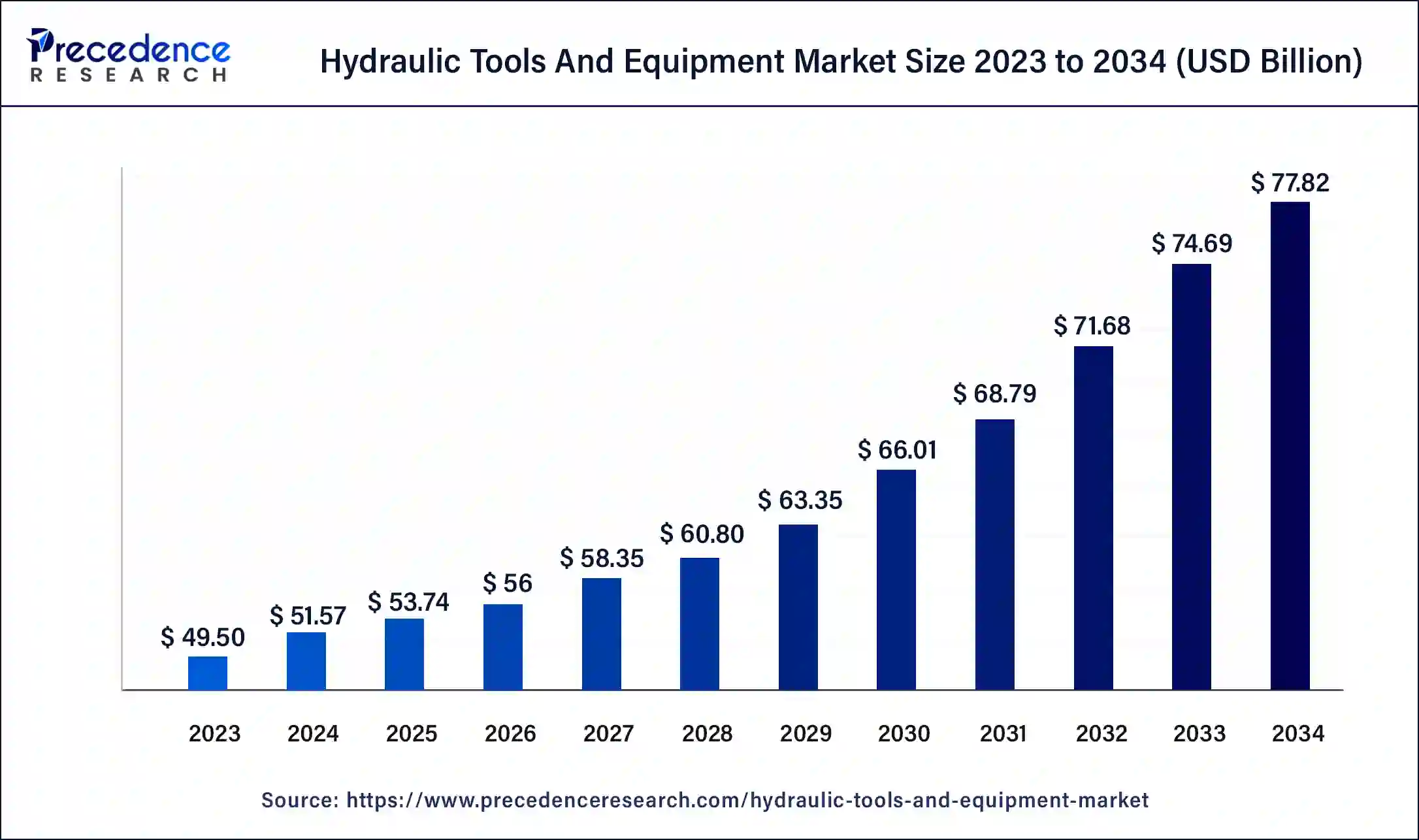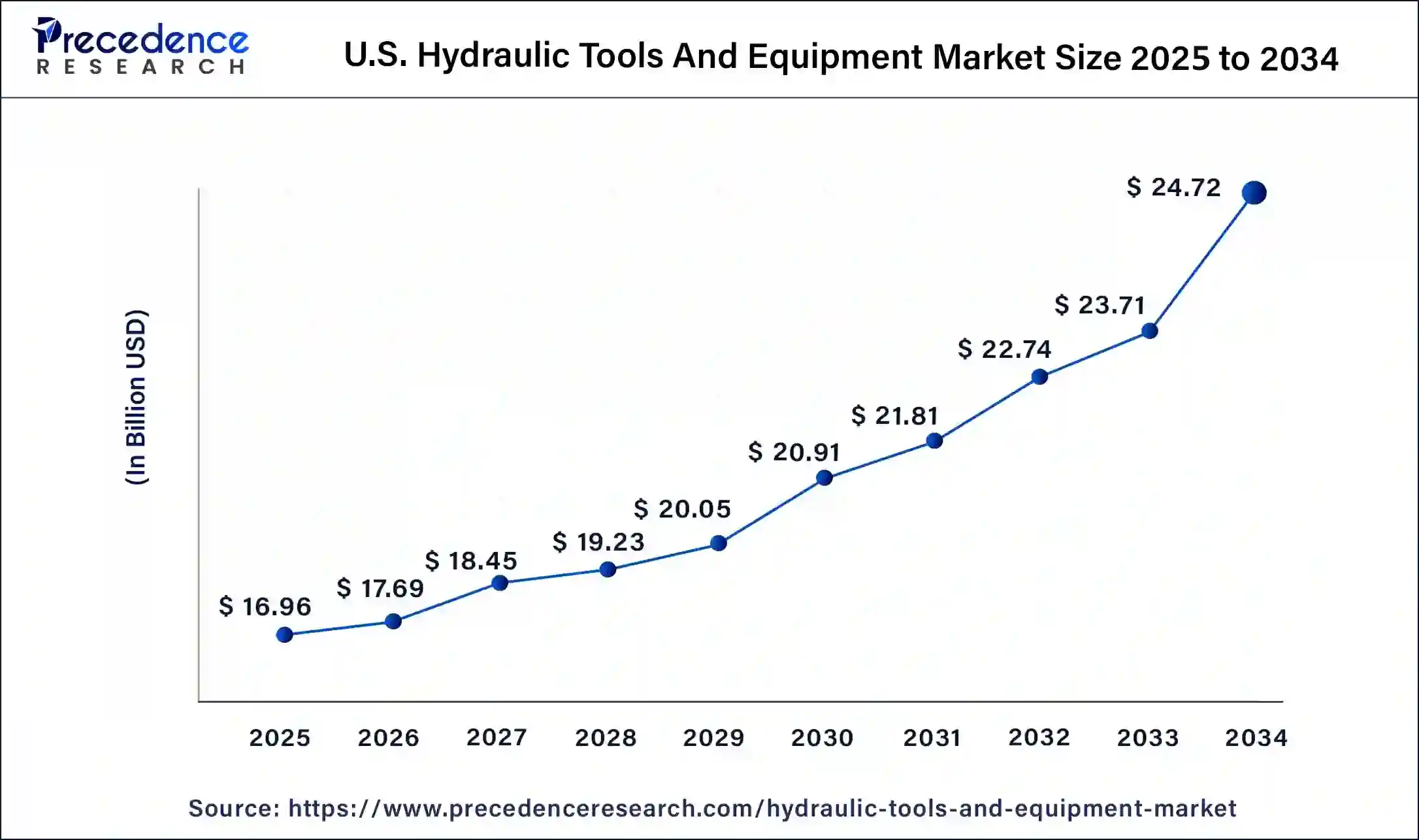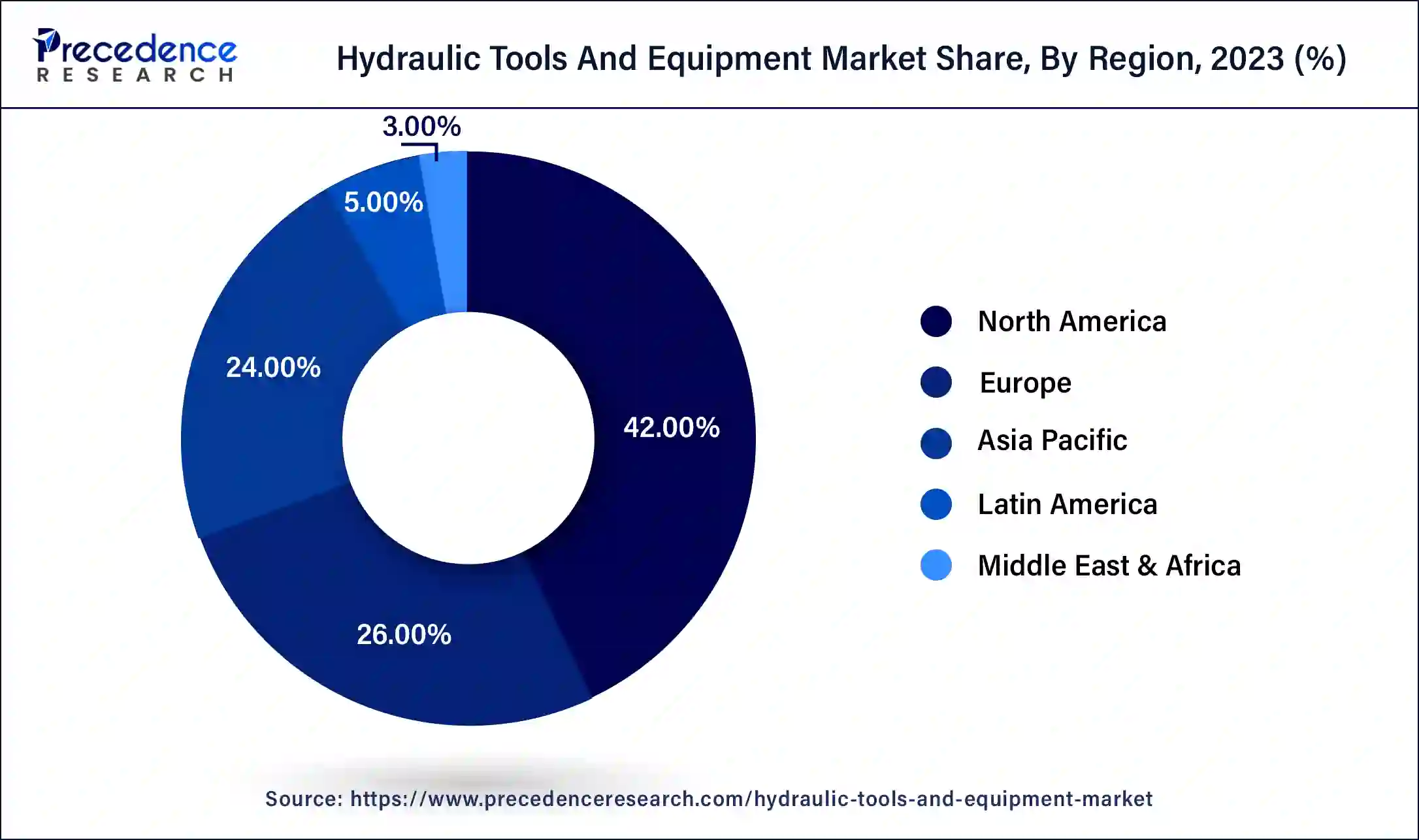September 2025
The global hydraulic tools and equipment market size is expected to be valued at USD 51.57 billion in 2024 and is anticipated to reach around USD 77.82 billion by 2034, expanding at a CAGR of 4.2% over the forecast period 2024 to 2034. The North America hydraulic tools and equipment market size reached USD 20.79 billion in 2023.

The U.S. hydraulic tools and equipment market size was exhibited at USD 15.60 billion in 2023 and is projected to be worth around USD 24.72 billion by 2034, poised to grow at a CAGR of 4.3% from 2024 to 2034.

North America has held the largest revenue share of 42% in 2023. North America holds a major share in the hydraulic tools and equipment market due to several factors. The region benefits from a strong industrial and manufacturing base, driving the demand for hydraulic systems in various applications. Moreover, the construction and infrastructure development sector remain robust, further boosting the market.
Additionally, the presence of well-established players in the hydraulic equipment industry, coupled with investments in research and development, contributes to technological advancements. Regulatory initiatives towards eco-friendly hydraulic solutions, along with the region's focus on safety and automation, also play a significant role in North America's dominant position in the hydraulic tools and equipment market.

Asia Pacific is estimated to observe the fastest expansion. Asia Pacific holds a major share in the hydraulic tools and equipment market due to several key factors. First, rapid industrialization and extensive infrastructure development projects across countries like China and India have spurred demand for hydraulic equipment in construction and manufacturing. Second, the burgeoning automotive and aerospace sectors in this region require hydraulic systems for various applications.
Additionally, the region's focus on renewable energy, agriculture, and mining contributes to the significant demand for hydraulic tools. Lastly, the presence of numerous manufacturing hubs and a skilled labor force makes Asia Pacific a prime market for hydraulic tool suppliers, driving its dominance.
Hydraulic tools and equipment are mechanical devices that utilize the power of pressurized fluids, typically oil or water, to perform various tasks and operations. They are widely used in various industries for their ability to generate substantial force and precise control, making them essential in applications ranging from construction and manufacturing to automotive repair and aerospace engineering. Hydraulic equipment includes notable examples like hydraulic jacks for lifting hefty loads, hydraulic presses for shaping materials, and hydraulic cylinders for controlled linear movement. The versatility and might of hydraulic tools render them pivotal for a multitude of industries, facilitating the completion of tasks that would otherwise be arduous or unattainable through conventional mechanical means.
| Report Coverage | Details |
| Market Size in 2023 | USD 49.50 Billion |
| Market Size in 2024 | USD 51.57 Billion |
| Market Size by 2034 | USD 77.82 Billion |
| Growth Rate from 2024 to 2034 | CAGR of 4.2% |
| Largest Market | North America |
| Base Year | 2023 |
| Forecast Period | 2024 to 2034 |
| Segments Covered | By Type, By End User, and By Component |
| Regions Covered | North America, Europe, Asia-Pacific, Latin America, and Middle East & Africa |
Industrial applications and essential oils extraction
Infrastructure development and industrial automation play pivotal roles in surging the market demand for hydraulic tools and equipment. Firstly, infrastructure development projects, such as the construction of roads, bridges, airports, and buildings, are major drivers of hydraulic equipment demand. These projects require heavy machinery for excavation, lifting, and material handling, all of which rely on hydraulic systems for their power and precision. The need for modern, efficient, and durable construction equipment is continuously on the rise, and hydraulic tools are integral to meeting these requirements.
As urbanization and economic growth continue worldwide, the demand for hydraulic equipment in infrastructure development is expected to increase. Secondly, industrial automation is transforming manufacturing and industrial processes. Automation technologies require highly precise and controlled movements, and hydraulic systems excel in providing the necessary force and accuracy. Whether it's in robotics, CNC machines, or assembly lines, hydraulic components contribute to increased efficiency, reduced downtime, and improved product quality. With the ongoing trend toward smart factories and Industry 4.0, the reliance on hydraulic tools and equipment for automation purposes is expected to grow significantly, further boosting market demand.
Maintenance requirements and competition from alternative technologies
Maintenance requirements and competition from alternative technologies are significant restraints on the growth of the hydraulic tools and equipment market. Maintenance demands pose a substantial challenge as hydraulic systems require regular servicing and upkeep, which can be costly and time-consuming. The need for fluid changes, leak detection and repair, and component replacement can result in operational downtime, increased operational costs, and resource allocation. This can be particularly burdensome for industries aiming for uninterrupted production and cost-efficient operations.
Competition from alternative technologies, such as electric and pneumatic systems, is intensifying. These alternatives often offer cleaner and more energy-efficient operation, appealing to environmentally conscious industries and regions with stringent emissions regulations. Electric actuators and servo systems, for example, are gaining traction due to their precision, reduced maintenance needs, and energy savings. The hydraulic industry must address these competitive pressures by innovating and improving the energy efficiency and environmental performance of hydraulic tools to remain relevant and competitive in the market.
Smart manufacturing and hydraulic hybrid vehicles
Smart manufacturing, driven by Industry 4.0 principles, is revolutionizing the manufacturing landscape and creating significant opportunities in the hydraulic tools and equipment market. This transformation involves the integration of data, automation, and connectivity to optimize production processes. Hydraulic systems play a crucial role in smart manufacturing by providing precise and controllable motion, essential for automated machinery and robotics. Opportunities arise in the development of advanced hydraulic components, sensors, and control systems that align with the demands of smart factories, ensuring efficiency, quality, and adaptability.
Hydraulic hybrid vehicles represent another exciting opportunity for the industry. As the world strives for cleaner and more efficient transportation solutions, hydraulic hybrid technology offers the potential for significant fuel savings and emissions reduction. Hydraulic systems in these vehicles capture and store energy during braking and release it when needed for acceleration, enhancing overall efficiency. The adoption of hydraulic hybrid technology in commercial and heavy-duty vehicles, such as trucks and buses, presents a substantial growth avenue for hydraulic tools and equipment manufacturers looking to make a positive impact on the transportation sector's environmental footprint.
In 2023, the hydraulic cylinder and jack segment had the highest market share of 41% based on the type. In the hydraulic tools and equipment market, the hydraulic cylinder segment includes devices that convert hydraulic fluid power into linear mechanical force. These cylinders are widely used in various applications, from construction machinery to industrial automation, for controlled and precise linear motion.
The hydraulic jack segment encompasses tools designed for lifting heavy loads using hydraulic pressure. They are employed in automotive repair, construction, and material handling. The trend in these segments includes the development of compact and lightweight designs, enhanced safety features, and increased efficiency to meet the demand for more versatile and eco-friendly hydraulic solutions in diverse industries.
The tension and torque tools segment is anticipated to expand at a significant CAGR of 4.9% during the projected period. The tension and torque tools segment in the hydraulic tools and equipment market includes devices designed to measure and apply controlled force and rotational power. Tension tools are used to precisely measure and apply tension to fasteners, while torque tools ensure accurate torque application to achieve proper fastening and prevent over-tightening. Trends in this segment include the increasing demand for high-precision tension and torque tools to meet the stringent quality standards in industries like automotive and aerospace. Additionally, the integration of smart and digital features in these tools, such as real-time data monitoring and wireless connectivity, is gaining prominence, enabling enhanced control and traceability in industrial applications.
According to the component, the pumps segment held a 26% revenue share in 2023. The pumps segment in the hydraulic tools and equipment market comprises the devices responsible for generating hydraulic fluid pressure. These components are essential for converting mechanical power into hydraulic power, driving various hydraulic systems. Key trends in this segment include a shift towards more energy-efficient and environmentally friendly pump designs, aligning with sustainability goals. Furthermore, the integration of advanced technologies, such as digital controls and condition monitoring, is on the rise, enhancing pump performance, reducing downtime, and enabling predictive maintenance strategies. These trends reflect the industry's commitment to innovation, efficiency, and sustainability in hydraulic pump technology.
The transmission segment is anticipated to expand fastest over the projected period. The transmission segment in the hydraulic tools and equipment market encompasses the components responsible for transmitting hydraulic power, typically through fluid, to various parts of the machinery. This includes pumps, valves, hoses, and connectors.
The transmission components play a critical role in controlling the flow and pressure of hydraulic fluid, enabling precise and efficient operation in hydraulic systems. Trends in the transmission segment involve advancements in component design for improved efficiency and reliability. These trends include the development of energy-efficient pumps, intelligent control systems for better fluid management, and the integration of digital technologies for real-time monitoring and predictive maintenance, ensuring the seamless and reliable operation of hydraulic equipment.
In 2023, the industrial manufacturing segment had the highest market share of 31% on the basis of the end user. The industrial manufacturing segment in the hydraulic tools and equipment market comprises businesses involved in the production of goods across various industries. These end users rely on hydraulic tools for precision, control, and force in manufacturing processes. Trends in this segment include the increasing integration of hydraulic systems into automated manufacturing processes to enhance efficiency and productivity.
Additionally, the development of more energy-efficient and eco-friendly hydraulic solutions aligns with the growing emphasis on sustainability in industrial manufacturing, meeting both performance and environmental requirements.
The railway segment is anticipated to expand fastest over the projected period. In the hydraulic tools and equipment market, the railway segment refers to the use of hydraulic systems within the railway industry. These systems are essential for various applications in this sector, including train braking systems, track maintenance, and even the operation of hydraulic doors and ramps in passenger and freight trains.
A notable trend in the railway segment is the increasing adoption of hydraulic systems for high-speed trains and modern locomotives, as they offer precise control and reliable performance. Additionally, there is a growing focus on enhancing the safety and efficiency of railway operations through the integration of advanced hydraulic technology, promoting the continued growth of this market segment.
Segments Covered in the Report
By Type
By End User
By Component
By Geography
For inquiries regarding discounts, bulk purchases, or customization requests, please contact us at sales@precedenceresearch.com
No cookie-cutter, only authentic analysis – take the 1st step to become a Precedence Research client
September 2025
June 2025
January 2025
October 2025